TV Shows
RuPaul’s Drag Race
RuPaul’s Drag Race is an American reality television show that features drag queens from all over the country. These gender-nonconforming entertainers are put to the test as they compete in weekly challenges involving acting, singing, dancing, and performing. The show has been running since 2009, and has recently been gaining more and more mainstream popularity, which has caused a lot of intermixing between queer and non-queer communities in regards to pop culture, especially within younger generations. The show heavily references the documentary called Paris is Burning about drag entertainers in 1980s Harlem, and through callbacks to ideas like “reading,” voguing, and many other  popular pieces of dialogue from the film, it is easy to draw the lines connecting the two. The host of the show is none other than RuPaul himself, a world-famous drag performer, singer, and entrepreneur, who came up in the ball scenes described in the previously mentioned documentary. The show presents some of the most diverse and creative people on television, as they are repeatedly tasked with creating entire outfits, routines, and skits on their own in a matter of a couple days. As it is a reality show, it is not without its fair share of drama, but unlike other shows on television, one thing that connects all of these individuals is their shared identity as LGBT+, and at the end of the day, the show heavily pushes on the theme of inclusion and community. Although there is a heavy focus on comedy, the show does not leave any topic undiscussed. Even through conversations about topics such as the AIDS crisis, anti-queer violence, racism, eating disorders, mental illness, and abandonment, the show is able to radiate a feeling of love and acceptance because of this shared connection that links all of the contestants. These reasons and more are why RuPaul’s Drag Race has lasted (and grown) as a queer-based form of entertainment in such a heteronormative society.
popular pieces of dialogue from the film, it is easy to draw the lines connecting the two. The host of the show is none other than RuPaul himself, a world-famous drag performer, singer, and entrepreneur, who came up in the ball scenes described in the previously mentioned documentary. The show presents some of the most diverse and creative people on television, as they are repeatedly tasked with creating entire outfits, routines, and skits on their own in a matter of a couple days. As it is a reality show, it is not without its fair share of drama, but unlike other shows on television, one thing that connects all of these individuals is their shared identity as LGBT+, and at the end of the day, the show heavily pushes on the theme of inclusion and community. Although there is a heavy focus on comedy, the show does not leave any topic undiscussed. Even through conversations about topics such as the AIDS crisis, anti-queer violence, racism, eating disorders, mental illness, and abandonment, the show is able to radiate a feeling of love and acceptance because of this shared connection that links all of the contestants. These reasons and more are why RuPaul’s Drag Race has lasted (and grown) as a queer-based form of entertainment in such a heteronormative society.
Legend of Korra
Legend of Korra is an animated American television series created by the duo of Bryan Konietzko and Michael Dante DiMartino. The show aired on Nickelodeon, and ran between the years of 2012 and 2014. Legend of Korra is a four-season continuation of the wildly popular series, Avatar: the Last Airbender, which itself has received numerous awards and acclaims. The show broke racial, 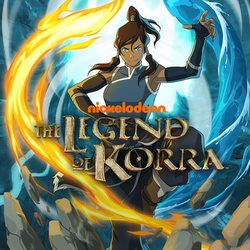 political, and sexual grounds, and became easily one of the most socially-progressive animated shows of all time. It follows the story of Korra, a hot-headed young hero who must go through many tests and face several adversaries before unlocking her true Avatar potential. The show is heavily influenced by Japanese animation, and features a world that is one of the most cohesive and fully-realized of any television series. As the story progresses, Korra finds herself struggling on not only a physical and spiritual journey, but a romantic one as well. Through the latter half of the series especially, we see a romantic arch develop in the plot between Korra and another female character. The creators of the show had the idea to make Korra queer early on, but knew that the idea wouldn’t fly on a kid’s network. As time went on, thought of making Korra visibly queer became more of a reality. The creators also loved the idea of representing LGBT+ people, who are so often marginalized in society, on a mainstream platform. Legend of Korra made history as the first American children’s animated series to feature a canonically bisexual heroine. The series continues in a set of comic books entitled “Turf Wars,” which are set to release beginning summer 2017.
political, and sexual grounds, and became easily one of the most socially-progressive animated shows of all time. It follows the story of Korra, a hot-headed young hero who must go through many tests and face several adversaries before unlocking her true Avatar potential. The show is heavily influenced by Japanese animation, and features a world that is one of the most cohesive and fully-realized of any television series. As the story progresses, Korra finds herself struggling on not only a physical and spiritual journey, but a romantic one as well. Through the latter half of the series especially, we see a romantic arch develop in the plot between Korra and another female character. The creators of the show had the idea to make Korra queer early on, but knew that the idea wouldn’t fly on a kid’s network. As time went on, thought of making Korra visibly queer became more of a reality. The creators also loved the idea of representing LGBT+ people, who are so often marginalized in society, on a mainstream platform. Legend of Korra made history as the first American children’s animated series to feature a canonically bisexual heroine. The series continues in a set of comic books entitled “Turf Wars,” which are set to release beginning summer 2017.
Sense8
Sense8 is an American science fiction drama series that was created by Lana and Lilly Wachowski and J. Michael Straczynski for Netflix. The show, which has been running since 2015, currently has two seasons and features a multinational main cast. The premise for Sense8 is that a group of eight individuals from all over the world are connected 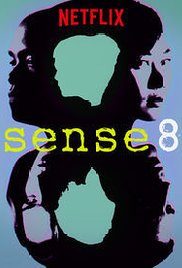 through some sort of psycho-sensual phenomena that allows them to share their body and mind, as well as their shared experience and expertise. The show features several queer characters, including Nomi, a transwoman and Lito, a closeted gay man. Although these characters are the only ones in queer relationships on the show, due to the shared cognitive experience that each of the “sensates” feel, they are all canonically pansexual. Aside from sexuality, the show also plays heavily on themes of race, religion, politics, and gender, and features realistic struggles with things like AIDS, transphobia, organized crime, harmful traditions, and misogyny. Sense8 won the GLAAD Media Award for Outstanding Drama Series due to its vast representation of the LGBT+ community. The show has received great reviews for its authenticity; not only does it represent people with varying intersections of identity well, but it is also filmed on location in cities around the globe. It’s a must-watch for anyone looking to binge on quality queer content.
through some sort of psycho-sensual phenomena that allows them to share their body and mind, as well as their shared experience and expertise. The show features several queer characters, including Nomi, a transwoman and Lito, a closeted gay man. Although these characters are the only ones in queer relationships on the show, due to the shared cognitive experience that each of the “sensates” feel, they are all canonically pansexual. Aside from sexuality, the show also plays heavily on themes of race, religion, politics, and gender, and features realistic struggles with things like AIDS, transphobia, organized crime, harmful traditions, and misogyny. Sense8 won the GLAAD Media Award for Outstanding Drama Series due to its vast representation of the LGBT+ community. The show has received great reviews for its authenticity; not only does it represent people with varying intersections of identity well, but it is also filmed on location in cities around the globe. It’s a must-watch for anyone looking to binge on quality queer content.
Anime
Yuri on Ice
Yuri on Ice is a 12-episode anime television series that aired in the fall season of 2016. It tells the story of Yuri Katsuki, who was once Japan’s most promising figure skater. Reeling from his crushing defeat at the Grand Prix Finale, Yuri returns to his family home to assess his options for the future. At age 23, Yuri’s window for success in skating is closing rapidly. His depression continues to weigh him down and keep him from practicing for the next Grand Prix. However, Yuri finds himself in the spotlight when a video of him performing a routine previously executed by five-time world champion, Victor Nikiforov, suddenly goes viral. In fact, Victor himself abruptly appears at Yuri’s house and  offers to be his mentor. As one of his biggest fans, Yuri eagerly accepts, kicking off his journey to make it back onto the world stage. But the competition is fierce, as the rising star from Russia, Yuri Plisetsky, is relentlessly determined to defeat Yuri and win back Victor’s tutelage. Yuri on Ice is a story about competition, self-discovery, and most of all, love. Yuri is motivated by his love for his family and hometown but most of all for Victor. Victor, who lost all inspiration after years of skating, finds himself drawn to Yuri and falls in love with him as well. Together, Victor and Yuri fight there way to the top of the podium as coach and skater, all while falling in love along the way. Yuri on Ice is particularly remarkable for showcasing a homosexual relationship in a positive light, which is a step the anime industry had not taken many times before.
offers to be his mentor. As one of his biggest fans, Yuri eagerly accepts, kicking off his journey to make it back onto the world stage. But the competition is fierce, as the rising star from Russia, Yuri Plisetsky, is relentlessly determined to defeat Yuri and win back Victor’s tutelage. Yuri on Ice is a story about competition, self-discovery, and most of all, love. Yuri is motivated by his love for his family and hometown but most of all for Victor. Victor, who lost all inspiration after years of skating, finds himself drawn to Yuri and falls in love with him as well. Together, Victor and Yuri fight there way to the top of the podium as coach and skater, all while falling in love along the way. Yuri on Ice is particularly remarkable for showcasing a homosexual relationship in a positive light, which is a step the anime industry had not taken many times before.
Neon Genesis Evangelion
Neon Genesis Evangelion is a heroic tale of a young bisexual boy who will become a legend. In the year 2015, the world stands on the brink of destruction. Humanity’s last hope lies in the hands of Nerv, a special agency under the United Nations, and their Evangelions, giant machines capable of defeating the Angels who herald Earth’s ruin. Gendou Ikari, head of the organization, seeks 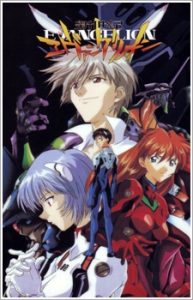 compatible pilots who can synchronize with the Evangelions and realize their true potential. Face to face with his father for the first time in years, 14-year-old Shinji Ikari’s life is irreversibly changed when he is whisked away into the depths of Nerv, and into a harrowing new destiny— he must become the pilot of Evangelion Unit-01 with the fate of mankind on his shoulders. Director Hideaki Anno’s depression is what led to the dark themes of Neon Genesis Evangelion. The series’ mix of psychoanalysis, religious symbolism, and genre deconstruction proved extremely influential on mature anime in the late ’90s onward. Shinji’s bisexuality and romantic involvement with Kaworu, another male character in the series, was a huge topic of debate when the series was first released in manga format. The Japan Media Arts Festival in 2006 ranked it as the most popular anime of all time.
compatible pilots who can synchronize with the Evangelions and realize their true potential. Face to face with his father for the first time in years, 14-year-old Shinji Ikari’s life is irreversibly changed when he is whisked away into the depths of Nerv, and into a harrowing new destiny— he must become the pilot of Evangelion Unit-01 with the fate of mankind on his shoulders. Director Hideaki Anno’s depression is what led to the dark themes of Neon Genesis Evangelion. The series’ mix of psychoanalysis, religious symbolism, and genre deconstruction proved extremely influential on mature anime in the late ’90s onward. Shinji’s bisexuality and romantic involvement with Kaworu, another male character in the series, was a huge topic of debate when the series was first released in manga format. The Japan Media Arts Festival in 2006 ranked it as the most popular anime of all time.
Nabari No Ou
Nabari No Ou is a centered around a boy named Miharu who is apathetic about the world around him, but it incidentally turns out that his body is carrying the scroll of the most powerful secret ninja art in the world of Nabari called the Shinra Banshou. Of course he wants nothing to do with ninjas, but he ends up being a part of a clan that protects him from The Grey Wolves, who want to use 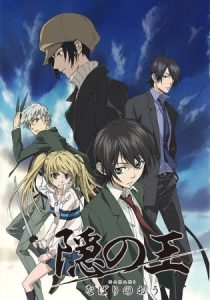 forbidden ninja arts to remove the Shinra Banshou from Miharu. Along the way, Miharu meets Yoite, an intersex character (presenting as male) who is being manipulated by the Grey Wolves to use the forbidden art of Kira against him. Yoite, in return for making Miharu the Nabari King, wants Miharu to get rid of his existence. Miharu agrees to help him, and Yoite leaves the Grey Wolves to join him, only for them to form a bond that grows closer and closer as time goes by and conflict increases. There are confirmed bisexual, homosexual and asexual characters and relationships. The author of the series, Yuhki Kamatani, is openly asexual and identifies as x-gender, which is an exclusively Japanese term. In English-speaking countries, the term agender is used and has the same meaning as x-gender.
forbidden ninja arts to remove the Shinra Banshou from Miharu. Along the way, Miharu meets Yoite, an intersex character (presenting as male) who is being manipulated by the Grey Wolves to use the forbidden art of Kira against him. Yoite, in return for making Miharu the Nabari King, wants Miharu to get rid of his existence. Miharu agrees to help him, and Yoite leaves the Grey Wolves to join him, only for them to form a bond that grows closer and closer as time goes by and conflict increases. There are confirmed bisexual, homosexual and asexual characters and relationships. The author of the series, Yuhki Kamatani, is openly asexual and identifies as x-gender, which is an exclusively Japanese term. In English-speaking countries, the term agender is used and has the same meaning as x-gender.
Hourou Musuko
Hourou Musuko is about an effeminate fifth grader Shuuichi Nitori, who is considered by most to be one of the prettiest girls in school. She is actually a transgirl. Fortunately, Shuuichi has a childhood friend who has similar feelings of discomfort related to gender identity: the lanky transboy Yoshino Takatsuki.  These two friends share a similar secret and find solace in one another; however, their lives become even more complicated when they must tread the unfamiliar waters of a new school, attempt to make new friends, and struggle to maintain old ones. Faced with nearly insurmountable odds, they must learn to deal with the harsh realities of growing up, dealing with their transgender identities, relationships, and acceptance. Lauded as a decidedly serious take on gender identity and LGBT struggles, Takako Shimura’s Hourou Musuko is about Shuuichi and Yoshino’s attempts to discover their true selves as they enter puberty, make friends, fall in love, and face some very real and difficult choices. Hourou Musuko won the Best Animated Broadcast Release at the 65th Motion Picture and Television Engineering Society of Japan Awards in 2012.
These two friends share a similar secret and find solace in one another; however, their lives become even more complicated when they must tread the unfamiliar waters of a new school, attempt to make new friends, and struggle to maintain old ones. Faced with nearly insurmountable odds, they must learn to deal with the harsh realities of growing up, dealing with their transgender identities, relationships, and acceptance. Lauded as a decidedly serious take on gender identity and LGBT struggles, Takako Shimura’s Hourou Musuko is about Shuuichi and Yoshino’s attempts to discover their true selves as they enter puberty, make friends, fall in love, and face some very real and difficult choices. Hourou Musuko won the Best Animated Broadcast Release at the 65th Motion Picture and Television Engineering Society of Japan Awards in 2012.
Revolutionary Girl Utena
Revolutionary Girl Utena blends surrealist imagery and ideas with complex allegories and metaphors to create a unique coming-of-age story with themes including idealism, illusions, adulthood, and identity. After meeting a traveling prince who consoled her after the deaths of her parents, Utena Tenjou vowed to become a prince herself. The prince left Utena only with a ring bearing a strange rose crest and a promise that she would meet him again someday. A few years 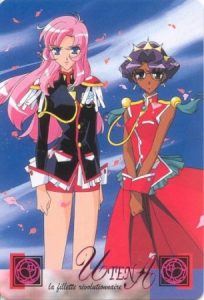 later, Utena attends Ootori Academy, where she is drawn into a dangerous game. Duelists with rings matching Utena’s own compete for a unique prize: the Rose Bride, Anthy Himemiya, and her mysterious powers. Childhood idealism, illusions, ambition, adulthood, sexuality, abuse, incest and identity are all prominent themes which are explored in what is essentially a highly metaphorical and symbolic coming-of-age story. Loss of innocence, both sexual and otherwise, is treated as a life changing event. Fairy tale archetypes such as the noble prince and the damsel in distress, as well as standard tropes of the shoujo and magical girl genre are incorporated, subverted, inverted, averted and deconstructed. Revolutionary Girl Utena won the Best TV Animation Award at Animation Kobe in 1997.
later, Utena attends Ootori Academy, where she is drawn into a dangerous game. Duelists with rings matching Utena’s own compete for a unique prize: the Rose Bride, Anthy Himemiya, and her mysterious powers. Childhood idealism, illusions, ambition, adulthood, sexuality, abuse, incest and identity are all prominent themes which are explored in what is essentially a highly metaphorical and symbolic coming-of-age story. Loss of innocence, both sexual and otherwise, is treated as a life changing event. Fairy tale archetypes such as the noble prince and the damsel in distress, as well as standard tropes of the shoujo and magical girl genre are incorporated, subverted, inverted, averted and deconstructed. Revolutionary Girl Utena won the Best TV Animation Award at Animation Kobe in 1997.
No.6
Originally a nine-volume series of novels written by Atsuko Asano, No.6 has been adapted into an anime as well as a manga illustrated by Hinoki Kino. This science fiction story centers around the supposedly utopian city No.6. Shion’s intelligence has marked him out as an elite and allows him to have special privileges, however he loses those privileges after helping a boy on the run hide 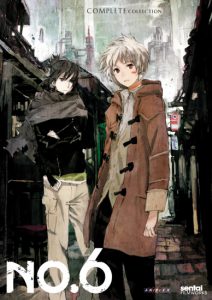 from the city authorities. Years later that boy, returns the favor and saves Shion from being imprisoned by those same authorities. The boy, named Nezumi (or Rat in English), takes Shion from his sheltered city life to to world outside the walls of No.6. All seems well until Shion learns that his childhood friend Safu has been imprisoned by the authorities, and resolves himself to the seemingly impossible task of saving her. This decision leads Shion and Nezumi’s attempt to take down the corrupt administration of No.6, all while helping each other grow as individuals and falling in love. Both the anime and the manga adaptations of No.6 have been officially translated into English. The original novels have never been translated officially, but unofficial translations are available at Nostalgia on 9th Avenue.
from the city authorities. Years later that boy, returns the favor and saves Shion from being imprisoned by those same authorities. The boy, named Nezumi (or Rat in English), takes Shion from his sheltered city life to to world outside the walls of No.6. All seems well until Shion learns that his childhood friend Safu has been imprisoned by the authorities, and resolves himself to the seemingly impossible task of saving her. This decision leads Shion and Nezumi’s attempt to take down the corrupt administration of No.6, all while helping each other grow as individuals and falling in love. Both the anime and the manga adaptations of No.6 have been officially translated into English. The original novels have never been translated officially, but unofficial translations are available at Nostalgia on 9th Avenue.
Video Games
Gone Home
Gone Home is a first-person perspective exploration video game developed and published by The Fullbright Company in 2013. The game begins with the player-character, Katie, coming home from a year of travelling abroad to a completely empty house circa 1995. It is given as exposition that Katie’s family consists of her father, Terry, a failed writer who writes reviews for home electronics; her mother, Janice, a wildlife conservationist who was recently promoted to a director 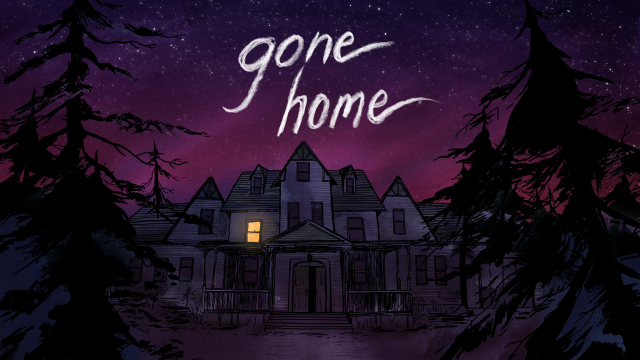 position; and her eighteen-year-old sister, Samantha. While the game itself lacks any “goals,” the player-character can explore their house and attempt to uncover clues as to why their family is nowhere to be seen. Upon approaching the front door, the player-character will find a note on the door from Sam imploring Katie not to investigate what happened. As the player further explores the house’s nooks and crannies, they discover the developing (and subsequently tumultuous) romance between Samantha and her girlfriend, Lonnie. Through the use of environmental storytelling, overarching themes of identity, abuse, coming of age, and ultimately love are hidden in the forms of found diary entries, hidden notes, and stashed magazines, all for the player to discover and piece together into a single cohesive story.
position; and her eighteen-year-old sister, Samantha. While the game itself lacks any “goals,” the player-character can explore their house and attempt to uncover clues as to why their family is nowhere to be seen. Upon approaching the front door, the player-character will find a note on the door from Sam imploring Katie not to investigate what happened. As the player further explores the house’s nooks and crannies, they discover the developing (and subsequently tumultuous) romance between Samantha and her girlfriend, Lonnie. Through the use of environmental storytelling, overarching themes of identity, abuse, coming of age, and ultimately love are hidden in the forms of found diary entries, hidden notes, and stashed magazines, all for the player to discover and piece together into a single cohesive story.
Life is Strange
Life Is Strange is an episodic adventure video game developed by Dontnod Entertainment and later published by Square Enix in 2015. The story takes place in the fictional town of Arcadia Bay, Oregon, where Max Caulfield returns after a five-year absence as a senior in the local high school. In the very beginning gameplay, it is discovered that Max has the ability to not only rewind time, but she is also able to permanently affect the past through her time control. After a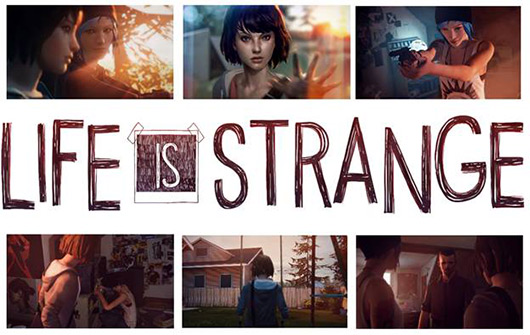 series of misfortunate events involving murder and the prevention thereof, she is finally reunited with her former friend, Chloe Price. The dynamic duo then unintentionally embarks on a harrowing adventure in an attempt to uncover the uncomfortable truths surrounding the mysterious disappearance of Chloe’s girlfriend, Rachel Amber. As the player-character explores the world of Arcadia Bay, information and lore can be found through interactions with the environment itself and the people in it. Choices made by the player-character are of the utmost-importance, as they decide the timeline in which the story continues. Life is Strange handles themes such as social division, online bullying, parental strife and suicide as significant life-altering events rather than plot devices, while still being an enjoyable and captivating experience for the player.
series of misfortunate events involving murder and the prevention thereof, she is finally reunited with her former friend, Chloe Price. The dynamic duo then unintentionally embarks on a harrowing adventure in an attempt to uncover the uncomfortable truths surrounding the mysterious disappearance of Chloe’s girlfriend, Rachel Amber. As the player-character explores the world of Arcadia Bay, information and lore can be found through interactions with the environment itself and the people in it. Choices made by the player-character are of the utmost-importance, as they decide the timeline in which the story continues. Life is Strange handles themes such as social division, online bullying, parental strife and suicide as significant life-altering events rather than plot devices, while still being an enjoyable and captivating experience for the player.
Undertale
Undertale is a role-playing video game published by American indie developer Toby Fox in 2015. Throughout the game, the player-character controls a child (who can be named by the player, but has a default name of Frisk) who has fallen from the top of Mount Ebbott into the Underground. This expansive and secluded region underneath the surface of the Earth is separated by a magical  barrier and is inhabited by a few hundred monsters. As Frisk first wakes up in the Underground, they are adopted by a monster by the name of Toriel, who is the first of many monsters that are introduced throughout the game. More importantly, Alphys and her girlfriend Undyne play an integral role throughout the many routes the game could take. The player meets these characters during their quest to return to the surface, mainly through the game’s combat system; the player navigates through mini game attacks by the opponent, and can opt to spare monsters instead of attacking and killing them. Not unlike many other games, choices are invaluable to the experience the player has during the story, as every decision has a consequence. Undertale showcases themes of mindfulness, determination, forgiveness, and the importance of giving everyone a fair chance while being simultaneously goofy and downright heartbreaking.
barrier and is inhabited by a few hundred monsters. As Frisk first wakes up in the Underground, they are adopted by a monster by the name of Toriel, who is the first of many monsters that are introduced throughout the game. More importantly, Alphys and her girlfriend Undyne play an integral role throughout the many routes the game could take. The player meets these characters during their quest to return to the surface, mainly through the game’s combat system; the player navigates through mini game attacks by the opponent, and can opt to spare monsters instead of attacking and killing them. Not unlike many other games, choices are invaluable to the experience the player has during the story, as every decision has a consequence. Undertale showcases themes of mindfulness, determination, forgiveness, and the importance of giving everyone a fair chance while being simultaneously goofy and downright heartbreaking.
Podcasts
The Adventure Zone
A Dungeons and Dragons podcast hosted by the McElroy brothers (and their dad) of My Brother, My Brother, and Me, The Adventure Zone 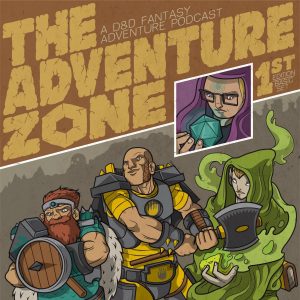 follows a small party of inexperienced adventurers as they explore an amazing fantasy world, committing daring deeds and slaying…kobolds…or whatever. In the current Balance Arc, Travis McElroy is Magnus Burnsides, a human Fighter and Folk Hero with a tragic past whose main character traits are his love of dogs and unquenchable impulse to rush into a fight. Justin McElroy is Taako, an Elven Wizard chef who enjoys looting fallen foes, cracking wise, and making goofs. Clint McElroy is Merle Highchurch, a Dwarven Cleric and (eventual) follower of the nature god, Pan, who still isn’t quite sure which die to roll when. Leading them through this magical world is Dungeon Master Griffin McElroy, whose initial hesitance evolves into beautiful, tragic, and hilariously witty storytelling as time goes on. The boys uncover a forgotten conflict that requires them to collect magical artifacts and save the world, but just how much do they really know? Queer and non-gender-conforming characters become more plentiful as the podcast goes on; the McElroys are inclusive and respectful, learn from past mistakes, and often state that they want to include representation for all of their fans, not just some.
follows a small party of inexperienced adventurers as they explore an amazing fantasy world, committing daring deeds and slaying…kobolds…or whatever. In the current Balance Arc, Travis McElroy is Magnus Burnsides, a human Fighter and Folk Hero with a tragic past whose main character traits are his love of dogs and unquenchable impulse to rush into a fight. Justin McElroy is Taako, an Elven Wizard chef who enjoys looting fallen foes, cracking wise, and making goofs. Clint McElroy is Merle Highchurch, a Dwarven Cleric and (eventual) follower of the nature god, Pan, who still isn’t quite sure which die to roll when. Leading them through this magical world is Dungeon Master Griffin McElroy, whose initial hesitance evolves into beautiful, tragic, and hilariously witty storytelling as time goes on. The boys uncover a forgotten conflict that requires them to collect magical artifacts and save the world, but just how much do they really know? Queer and non-gender-conforming characters become more plentiful as the podcast goes on; the McElroys are inclusive and respectful, learn from past mistakes, and often state that they want to include representation for all of their fans, not just some.
Night Vale Presents
Night Vale Presents is a podcast network led by Joseph Fink and Jeffrey Cranor. At the time of writing, every podcast associated with the network has main characters that are queer.
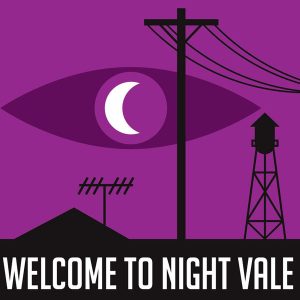 Welcome to Night Vale is the original and longest running podcast of the network. Night Vale is a strange town located somewhere in the American desert. The story of Night Vale is told is the form of a twice-monthly radio broadcast. The host and voice of Night Vale Cecil Palmer guides his audience through the bizarre occurrences that are the norm for citizens of Night Vale. Welcome to Night Vale delivers essential news regarding things such as the forbidden dog park and the hooded figures within, as well as the movements of the glowing cloud that rains down dead animals and the mayoral election between five-headed dragon Hiram McDaniels and The Faceless Old Woman Who Secretly Lives In Your Home. The broadcast also gives a glimpse into the lives of Night Vale residents such as Old Woman Josie and her household of angels who do not legally exist, along with the life of Cecil himself and his husband, Carlos the Scientist.
Welcome to Night Vale is the original and longest running podcast of the network. Night Vale is a strange town located somewhere in the American desert. The story of Night Vale is told is the form of a twice-monthly radio broadcast. The host and voice of Night Vale Cecil Palmer guides his audience through the bizarre occurrences that are the norm for citizens of Night Vale. Welcome to Night Vale delivers essential news regarding things such as the forbidden dog park and the hooded figures within, as well as the movements of the glowing cloud that rains down dead animals and the mayoral election between five-headed dragon Hiram McDaniels and The Faceless Old Woman Who Secretly Lives In Your Home. The broadcast also gives a glimpse into the lives of Night Vale residents such as Old Woman Josie and her household of angels who do not legally exist, along with the life of Cecil himself and his husband, Carlos the Scientist.
 Alice Isn’t Dead is a podcast created by Joseph Fink, one of the creators of Night Vale. The story is told in the form of a series of recordings by a woman who is searching for her lost wife Alice. The woman leaves her life behind and signs on as a truck driver in order to facilitate her search. Her recordings tell of her many strange encounters on the roads of America, most significantly her encounters with the Thistle Men, a menacing and murderous race. She soon discovers that Alice, Thistle Men, and even the trucking company she works for are all wrapped up in a dark conspiracy that she has yet to fully unravel.
Alice Isn’t Dead is a podcast created by Joseph Fink, one of the creators of Night Vale. The story is told in the form of a series of recordings by a woman who is searching for her lost wife Alice. The woman leaves her life behind and signs on as a truck driver in order to facilitate her search. Her recordings tell of her many strange encounters on the roads of America, most significantly her encounters with the Thistle Men, a menacing and murderous race. She soon discovers that Alice, Thistle Men, and even the trucking company she works for are all wrapped up in a dark conspiracy that she has yet to fully unravel.
 Also from a creator of Night Vale is Within the Wires, written by Jeffrey Cranor and Janina Matthewson. Within the Wires starts out as a series of cassette tapes that on the surface appear to simply be relaxation instructions for a patient in a futuristic mental hospital. As time goes on it becomes more and more clear that these tapes aren’t what they seem. Slowly, a story begins to take shape: a story of passion and connections lost and regained, and a story of two people struggling to find freedom in a world that isn’t as utopian as it’s made out to be.
Also from a creator of Night Vale is Within the Wires, written by Jeffrey Cranor and Janina Matthewson. Within the Wires starts out as a series of cassette tapes that on the surface appear to simply be relaxation instructions for a patient in a futuristic mental hospital. As time goes on it becomes more and more clear that these tapes aren’t what they seem. Slowly, a story begins to take shape: a story of passion and connections lost and regained, and a story of two people struggling to find freedom in a world that isn’t as utopian as it’s made out to be.
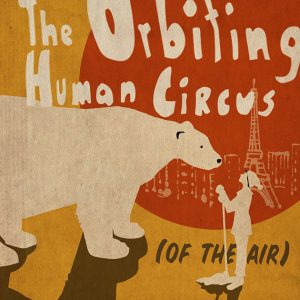 The Orbiting Human Circus is written by Julian Koster. This podcast tells the story of a fantastical radio show that broadcasts to a live audience from the top of the Eiffel tower. The main character is a janitor named Julian, a bumbling but enthusiastic soul who somehow always manages to interrupt the broadcasts in some way or another. As the listener hears stories of the radio show’s strange features and special guests, the divide between reality and imagination becomes more and more blurred.
The Orbiting Human Circus is written by Julian Koster. This podcast tells the story of a fantastical radio show that broadcasts to a live audience from the top of the Eiffel tower. The main character is a janitor named Julian, a bumbling but enthusiastic soul who somehow always manages to interrupt the broadcasts in some way or another. As the listener hears stories of the radio show’s strange features and special guests, the divide between reality and imagination becomes more and more blurred.
More information on all of these podcasts can be found on nightvalepresents.com. Scripts of Welcome to Night Vale episodes have been collected in print in Mostly Void, Partially Stars: Welcome to Night Vale Episodes Volume 1 and The Great Glowing Coils of the Universe: Welcome to Night Vale Episodes Volume 2. The Joseph Fink and Jeffrey Cranor have also written two novels set in Night Vale, Welcome to Night Vale: A Novel (Oct. 2015) and It Devours!: A Welcome to Night Vale Novel (Oct. 2017). Recordings of Night Vale live shows are available for purchase on Bandcamp and Itunes.
